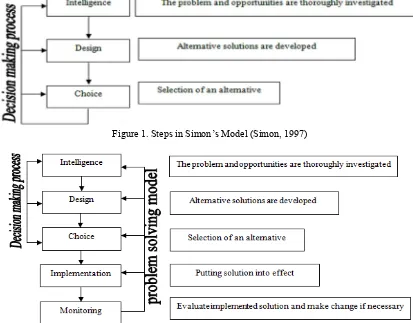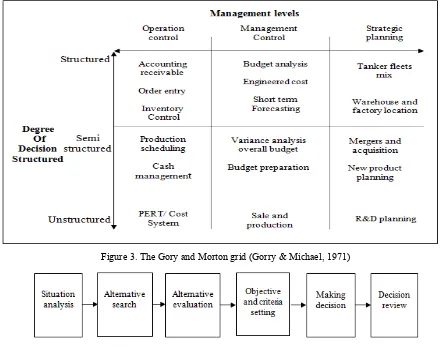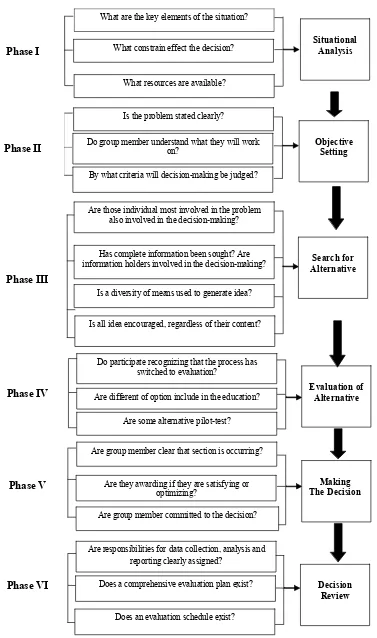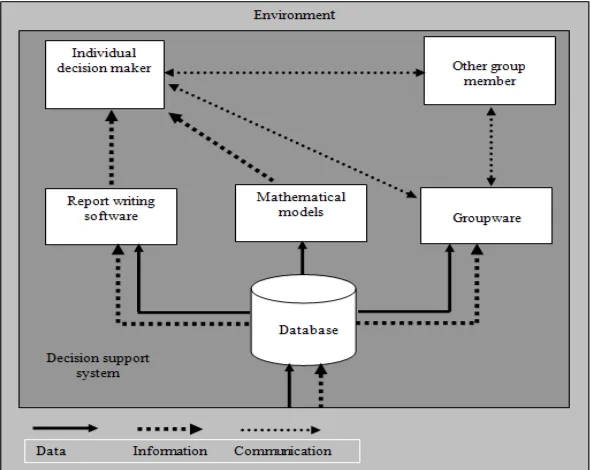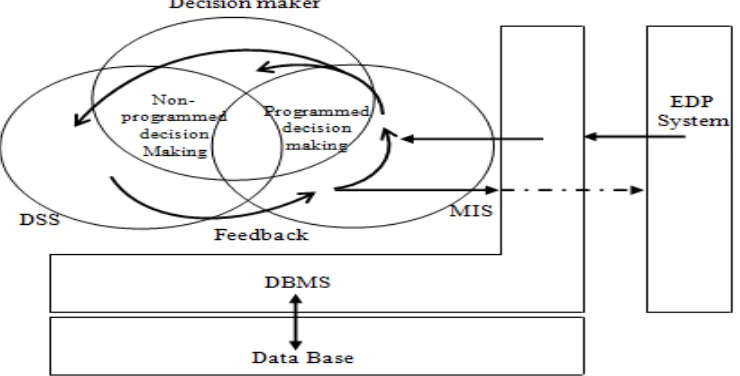The Role of Management Information System (MIS) and Decision
Support System (DSS) for Manager’s Decision Making Process
Asefeh Asemi, Ph.D
Department of Library and Information Sciences, University of Isfahan, Iran E-mail: [email protected]; [email protected]
Ali Safari, Ph.D
Department of Management, University of Isfahan, Iran
Adeleh Asemi Zavareh, Ph.D (Corresponding author)
Department of Artificial Intelligence, University of Malaya, Malaysia
Received: January 4, 2011 Accepted: February 10, 2011 doi:10.5539/ijbm.v6n7p164
Abstract
In today’s business world, there are varieties of information systems such as TPS, DAS, KWS, MIS, DSS, ES, CSCWS, GDSS and ESS. Each plays a different role in organizational hierarchy and decision making process. In this article the authors have selected two main information systems, namely, MIS and DSS. After discussing the decision making process based on each concept, its characteristics, relations, connections of each concept to decision-making process have been determined. At the same time, different models and figures are presented to enrich the discussion and to highlight precisely the status of each MIS and DSS information system in organizational decision making.
Keywords: Management information system, Decision support system, Managers, Decision making process 1. Introduction
For the last twenty years, different kinds of information systems are developed for different purposes, depending on the need of the business. Transaction Process Systems (TPS) function in operational level to process large amount of data for routine business transactions of the organization, Office Automation Systems (OAS) support data workers and Knowledge Work Systems (KWS) support professional workers. Higher-level systems include Management Information Systems (MIS) and Decision Support Systems (DSS). Expert System (ES) applies the expertise of decision makers to solve specific, unstructured problems. At the strategic level of management, there is Executive Support Systems (ESS). Group Decision Support Systems (GDSS) and the more generally described Computer Supported Collaborative Work (CSCW) systems aid group level decision making of a semi structured or unstructured decision.
In the present article the authors discuss two kinds of information systems, namely, MIS, and DSS, and then their characteristics, interrelationship and their relations with decision-making process in an organization. 2. Decision Making Process
In the 1950s, Herbert Simon and James March for the first time introduced a different decision making framework for understanding organizational behavior. Although they labored on the bureaucratic model by emphasizing on individual work in rational organizations and thus behaving rationally, their model added a new dimension: The idea that a human being’s rationality is limited. By offering a more realistic alternative to classical assumption of rational in decision-making, this model supported the behavioral view of individual and organizational functioning. The model suggested that when an individual makes decision, he examines a limited set of possible alternatives rather than all available options. “He accepts satisfactory or good enough” choices, rather than insist on optimal choices. He makes choices that are good enough because he does not search until he finds perfect solution to a problem (Gordon, 1993). Simon divided kinds of decisions into two basic types: programmed and non programmed decisions.
Programmed decisions are routine and repetitive decisions, and the organization typically develops specific ways to handle them. For this kind of routine repetitive decisions, standard arrangement decisions are typically made according to established management guidelines.
Insert figure 1 here
After Simon, Huber (1980) expanded the model for decision making process and added two steps into Simon’s model (Figure 2).
Insert figure 2 here
After them, Gorry and Morton (1971) classified decisions by its structure into three levels; structured decision, in which the ingredients, or variables, that comprise a decision are known and they can be measured quantitatively. Unstructured decision is one that the ingredients, or variables, that comprise a decision can not be measured quantitatively. Semi structured decision is in between structured and unstructured decisions. Usually most business decisions are semi structured. Then Gory and Morton continued on computer applications in terms of the degree of structure in the decision they are intended to make and the management level that they support (Gorry,Michael, 1971). Figure 3 shows the Gory and Morton grid.
Insert figure 3 here
A review of decision making literature reveals that the core process of decision making process consists of mainly six steps which are shown in Figure 4 and Figure 5.
Insert figure 4 here Insert figure 5 here
The six-step decision making process increases the likelihood that a high quality, accepted decision will result (Certo, 1997).
3. Management Information System (MIS)
Management information system (MIS) is one of the major computer based information systems. Its purpose is to meet the general information need of all the managers in the firm or in some organizational subunit of the firm. Subunit can be based on functional areas on management levels.
There are many definitions for MIS, but one of the most appropriate definitions describes management information system (MIS) as "an organizational method of providing past, present and projected information related to internal operations and external intelligence. It supports the planning, control and operation functions of an organization by furnishing uniform information in the proper time frame to assist the decision makers" (Waston, 1987). The information in MIS describes the firm or one of its major systems in terms of what has happened in the past, what is happening now and what is likely to happen in the future. The information is made is available in form of periodic reports, special reports and output of mathematical simulations. All managers use the information output as they make decisions to solve the firm’s problems (Raymond, 1990).
4. An MIS Model
An MIS model is illustrated in Figure 6. The database contains the data provided by accounting information system. In addition, both data and information are entered from the environment. The data based content is used by software that produces periodic and special report, as well as mathematical model that simulate various aspects of the firm operations. The software output is used by people who are responsible for solving the firm’s problems. Note that some of the decision maker might exist in the firm’s environment. The environment will involve once the firm bonds together with other organizations such as suppliers to form an Inter Organizational Information System (IOS). In such case, the MIS supplies information to the other member of the IOS (Raymond, 1990).
Insert figure 6 here 5. MIS Characteristics
In general, management information systems have a number of characteristic, which include the following: Report with fixed and standard formation. For example scheduled reports for inventory control may contain the same type of information placed in the same location on the reports.
Have report developed and implemented using information system personnel, including systems analysts and computer programmer. Typically analysts and programmers are involved in developing and implementing MIS reports. User is normally involved in the design of the reports, but they are not typically involved in writing the computer programs to produce them.
Require formal request from user. Because information systems personnel typically develop and implement MIS reports, a formal request to the information systems department for report is usually required. Produce scheduled and demand reports. The major type of reports produced by an MIS is scheduled; demand reports (Stair, 1992).
6. The role of MIS in decision making process
The MIS and its organizational subsystems contribute to decision making process in many basic ways. Nowadays, some of the organizations use MIS to assist managers for decision making. For example, to assist decision-makers in extracting synthesized information from a massive database such as the Current Public Transport Record (CPTR) of Durban (CPTR), the Durban Unicity Council decided to make use of a Public Transport Management Information System (PTMIS) developed by Stewart Scott. This system is for use by transport planners and managers (Louw et al, 2001).
Power (2002) has stated that making decisions is an important part of working in business environment. Companies often make decisions regarding operational improvements or selecting new business opportunities for maximizing the company's profit. Companies develop a decision-making process based on individuals responsible for making decisions and the scope of the company's business operations. A useful tool for making business decisions is a management information system (MIS). Historically, the MIS was a manual process used to gather information and funnel it to individuals responsible for making decisions.
6.1 Organization–wide information resource
The MIS is an organization – wide effort to provide decision making process information. The system is a formal commitment by executive to make the computer available to all managers. The MIS sets the stage for accomplishments in the other area, which is DSS, the virtual office and knowledge based systems.
6.2 Situation analysis, problem identification and understanding
The main idea behind the MIS is to keep a continuous supply of information flowing to the management. Afterward by data and information gathered from MIS system, make decisions.
7. Decision Support System (DSS)
A decision support system or DSS is a computer based system intended for use by a particular manager or usually a group of managers at any organizational level in making a decision in the process of solving a semi structured decision (Figure 7). The DSS produces output in the form of periodic or special report or the results of mathematical simulations (Raymond, 1990). It is difficult to pinpoint that are completely structured or unstructured. The vast majorities are semi structured. This means that the DSS is aimed at the area where most semi structured decision is needed to be made.
Insert figure 7 here 8. A DSS Model
A DSS model includes four parts as follows (Figure 8) (Raymond, 1998).
- Data base produces both internal and environmental data, which are stored in the database.
- Report writing software produces both periodic and special reports. Periodical reports are prepared according to a schedule and typically they are produced by software, which is coded in a procedural language such as COBOL or PL/I. The special report is prepared in response to unanticipated information need and takes form of database by users who use the query language of a DBMS or fourth generation language.
- Mathematical model produces information as a result of either simulation that involves one or more components of the physical system of the firm or facts of its operations. Mathematical models can be written in any procedural programming language. However, special model languages make this task easier and have the potential of doing a better job.
- Groupware enables multiple decision makers, working together as a group, to reach solutions. In this particular situation, the term GDSS, or a group decision support system is used. Perhaps the decision makers represent a committee or a project team. The group members communicate with one another both, directly and by means of the group ware.
The reports writing software and mathematical model have always been regarded as necessary DSS ingredients. As the DSS concept was broadened to provide support to two or more decision maker working together as a team or committee, the idea of special group oriented software or groupware, became a reality.
Insert figure 8 here 9. DSS Characteristics
Decision support system has a number of characteristics, which include following:
- DSS provide support for decision maker mainly in semi structured and unstructured situations by bringing together human judgment and computerized information. Such problem can not be solved (can not be solved conveniently) by other computerized systems, such as MIS.
- DSS provides support to individuals as well as to groups. Many organizational problems involve group decision-making. The less structured problem frequently requires the involvement of several individuals from different departments and organizational levels.
- Advanced DSS are equipped by a knowledge component, which enables the efficient and effective solution of very difficult problems (Turban & Aronson, 1998).
- A DSS can handle large amount of data for instance advanced database management package have allowed decision makers, to search database for information. A DSS can also solve problems where a small amount of data is required.
- A DSS can be developed using a modular approach. With this approach, separate functions of the DSS are placed in separate modules - program or subroutines-allowing efficient testing and implement of systems. It also allows various modules to be used for multiple purposes in different systems.
- A DSS has a graphical orientation. It has often been said that a picture is worth a thousand words. Today’s decision support systems can help managers make attractive, informative graphical presentations on computer screens and on printed documents. Many of today’s software packages can produce line drawing, pie chart, trend line and more. This graphical orientation can help decision makers a better understanding of the true situation in a given market place.
- A DSS support optimization and heuristic approach. For smaller problems, DSS has the ability to find the best (optimal) situation. For more complex problems, heuristics are used. With heuristic, the computer system can determine a very good-but not necessarily the best- solution. This approach gives the decision maker a great deal of flexibility in getting computer support for decision making activities.
- A DSS can perform “what – if" and goal – seeking analysis. “What – if “analysis is the process of making hypothetical change to problem data and observing impact of the results. In with” what – if “analysis, a manager can make changes to problem data (the number of automobiles for next month) and immediately see the impact on the requirement for subassemblies (engines, windows, etc.) (Stair, 1992). 10. The role of the DSS in the process of decision making
Previously it was mentioned that the MIS is best suited in identifying problems and helping managers understanding them to make suitable and correct decisions, but the main weakness of MIS is that it is not aimed at the specific need of the individual and group decision makers. Very often the MIS does not provide exactly the information that is needed to solve problems for individual and group decision making. DSS is tailored to the specific need of the individual and group managers. Therefore, the DSS can extend this support through the remaining steps (in objective and criteria setting, alternative search, alternative evaluation, making the decision and decision review) of the decision making. Finally DSS has more roles in decision-making and problem solving than MIS (Raymond, 1998). The other researches such as the following confirm this idea:
Uma (2009) has stated that a Decision Support System is an integrated set of computer tools allowing a decision maker to interact directly with computer to retrieve information useful in making semi structured and unstructured decisions. Example of this decisions include such things as merger and acquisition decisions, plant expansion, new product decisions portfolio management and marketing decisions.
Nokhbatolfoghahaayee et al (2010) have introduced a fuzzy decision support system (FDSS) with a new decision making structure, which can be applied to manage the crisis conditions in any large scale systems with many parameters. After receiving both functional variables of the system and fault signals, the FDSS makes proper decisions to make up and repair the distorted situation and the affected elements of the network according to its data base established through experience gathered from expert managers and decision models properly developed. These decisions are expressed in the form of some scenarios with different desirability degrees, which are determined by some properly developed fuzzy multi-criteria decision making methods, helping the manager choose the best one according to his discretion.
Alonso et al (2010) have presented an implemented web based consensus support system that is able to help, or even replace, the moderator in a consensus process where experts are allowed to provide their preferences using one of many types (fuzzy, linguistic and multi-granular linguistic) of incomplete preference relations.
These studies show the important and role of MIS during managers' decision making process. 11. Discussion
socio-cultural factors like birth rate, population rate, competitor's share of market and so on could be quantifiable data and be considered and used it the process of top level management decision making process.
Insert figure 9 here
In general, different kinds of data and information are suitable for decision-making in different levels of organizational hierarchy and require different information system to be placed. Such system could have explicit effect on each step of decision process in solving problems. At the same time each information system can not fulfill complete information needs of each level, but rather different information systems if integrated in different levels could satisfy information needs of a level and at the same time fulfill part of information needs of other levels. For example TPS fulfills the lower level needs of an organization but MIS furnishes data and information for lower and middle level management needs(Note 1) On the other hand, DSS furnishes information for middle level and higher level of organizational hierarchy and ES fulfills only higher level managerial needs. Clearly by segregating each IS, its particular function could be recognized and it's overlapping distinguished. The role of different information systems is depicted in Figure 10.
Insert figure 10 here
The perceived concepts, which are based on the role of MIS and DSS in the decision making process, especially with emphasize on MIS and DSS which provide information services for middle and higher level managers in the process of decision making are integrated in Figure 11.
Insert figure 11 here
In Figure 11 it could be noted that data from EDP system transfers to DBMS and helps managers to make programmed and non-programmed decisions (Note 2). The flow of data after moving from EDP system to DBMS will move from MIS level to DSS and at the same time part of processed data will be restored in EDP system.
12. Conclusion
Apart from variety of information system in business world, MIS and DSS were the main concern of present article. It was found that MIS is best suited to identify problems and help management to understand them to make suitable decisions. At the same time, MIS is not aimed to help particular and specific need of the individual and group decision making. On the other hand DSS are tailored to the specific need of individual and group managers. Therefore, it could be concluded, that DSS can extend its support to the same steps of decision making process and has more roles in decision-making and problem solving than MIS. Due to some practical limitations, may be some of steps of decision making process to be chosen and the others to be removed. It is important to consider which ones are preferred to the other ones. In future works can study on the role of other information systems for managers' decision making and comparative it to DSS and MIS.
References
Alonso, S., Herrera-Viedma, E., Chiclana, F., & Herrera, F. (2010). A web based consensus support system for group decision making problems and incomplete preferences. Information Sciences, 180(23), 1 December. 4477-4495.
Certo, S, C. (1997). Modern Management, diversity, quality, ethics and the global environment, 7th Ed, New Jersey, Prentice-Hall Inc.
Davis, G.B., & Olson, M.H. (1985). Management Information Systems, conceptual foundation, structure and development, 2nd. New York, McGraw-Hill.
Gordon, J.R. (1993). A diagnostic approach to organizational behavior, 4th Ed, New York, Prentice-Hall Inc, Englewood Cliffs, NJ.
Gorry, G. A., & Michael M.M.S. (1971). A. Framework for Management Information System. Sloan, Management Review, 13 (Fall), 55-70
Huber, G. P. (1980). Managerial decision making. Glenview, IL: Scott, Foresman and Co.
Louw, J.J., Van Zyl, N.J.W., & Meintsma, J. (2001). Development of a public transport management Information system to assist decision-making in the restructuring of public transport in Durban. 20th South African Transport Conference South Africa, 16 – 20 July. ‘Meeting the Transport Challenges in Southern Africa’ Organised by: Conference Planners, Conference Papers Produced by: Document Transformation Technologies. Nokhbatolfoghahaayee, H., Menhaj, M.B., & Shafiee, M. (2010). Fuzzy decision support system for crisis management with a new structure for decision making. Expert Systems with Applications, 37(5), May. 3545-3552.
Power, D. J. (2002). Decision Support Systems: Concepts and Resources for Managers. Editor, DSSResources.COM. Quorum Books division, Greenwood Publishing.
Raymond McLeod, Jr. (1998). Management Information Systems, 6th Ed. New Jersey: Prentice Hall.
Simon, H. (1997). Administrative Behavior: A Study of Decision-Making Processes in Administrative Organizations, 4th Ed. The Free Press.
Stair, R.M. (1992). Principles of Information Systems: A Managerial Approach. Boston: Boyd and Fraser Publishing Company.
Turban, E., & Aronson, J.E. (1998). Decision Support Systems and Intelligent Systems, 5th Ed., New Yourk: Prentice-Hall.
Uma, V.D. (May 13, 2009). Role of Decision Support System for Decision-Making Process in Global Business
Environment. From ezinearticles.com, Date Access: 1 Feb.2011. [Online] Available
http://ezinearticles.com/?Role-of-Decision-Support-System-For-Decision-Making-Process-in-Global-Business-E nvironment&id=2315787
Waston, H.J., Carroll, A. B., & Mann, R. I. (1987). Information Systems for Management. Plano, TX: Business Publications Inc.
Notes
Note 1. Reader are aware of this concept that from MIS has two different meanings are extracted. One is an information system which is in the layer of supervisory and middle level management and the other refers to all the layers of IS from lower to the top level of organizational hierarchy.
Note 2. Programmd decisions are similar to structured decisions and non-programmed decisions are equal to unstructured decisions.
Figure 1. Steps in Simon’s Model (Simon, 1997)
Figure 3. The Gory and Morton grid (Gorry & Michael, 1971)
Phase I
What are the key elements of the situation?
What constrain effect the decision?
What resources are available?
Situational Analysis
Is the problem stated clearly?
Do group member understand what they will work on?
By what criteria will decision-making be judged?
Objective Setting
Are those individual most involved in the problem also involved in the decision-making?
Has complete information been sought? Are information holders involved in the decision-making?
Is a diversity of means used to generate idea?
Is all idea encouraged, regardless of their content?
Search for Alternative
Do participate recognizing that the process has switched to evaluation?
Are different of option include in the education?
Are some alternative pilot-test?
Evaluation of Alternative
Are group member clear that section is occurring?
Are they awarding if they are satisfying or optimizing?
Are group member committed to the decision?
Making The Decision
Are responsibilities for data collection, analysis and reporting clearly assigned?
Does a comprehensive evaluation plan exist?
Does an evaluation schedule exist?
Decision Review
Figure 6. An MIS Model (Raymond, 1990)
Figure 7. The DSS focuses on semi structured problems (Raymond, 1990)
Figure 9. Information and Decision-Making (Certo, 1997)
Figure 10. Organization and Information System (Davis & Olson, 1985)
